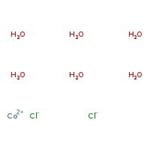Search Thermo Fisher Scientific
Cloruro de cobalto(II) hexahidrato, 98 %, Thermo Scientific Chemicals



Cloruro de cobalto(II) hexahidrato, 98 %, Thermo Scientific Chemicals
Identificadores químicos
Especificaciones
Descripción
This Thermo Scientific Chemicals brand product was originally part of the Alfa Aesar product portfolio. Some documentation and label information may refer to the legacy brand. The original Alfa Aesar product / item code or SKU reference has not changed as a part of the brand transition to Thermo Scientific Chemicals.
El cloruro de cobalto(II) hexahidrato se utiliza muy a menudo como agente de secado en la pintura y en colorantes de la cerámica de vidrio. Es un excelente indicador del agua en los desecantes, así como un indicador para el gel secante de sílice. Ayuda en la galvanoplastia. Actúa como inductor de la producción de HIF-1 utilizada para estudiar los efectos apoptóticos en las células de HepG2.
Solubilidad
Soluble en agua, éter, acetona y alcohol.
Notas
Incompatible con agentes oxidantes fuertes y metales.
Figuras
Documentos y descargas
Certificados
Preguntas frecuentes
Citas y referencias
Seguridad y manipulación
Classification of the substance or mixture
CLP classification - Regulation(EC) No 1272/2008
Label Elements
Signal Word
Danger
Hazard Statements
H302 + H332 - Harmful if swallowed or if inhaled
H317 - May cause an allergic skin reaction
H334 - May cause allergy or asthma symptoms or breathing difficulties if inhaled
H341 - Suspected of causing genetic defects
H350i - May cause cancer by inhalation
H360F - May damage fertility
H410 - Very toxic to aquatic life with long lasting effects
Precautionary Statements
P280 - Wear protective gloves/protective clothing/eye protection/face protection
P301 + P330 + P331 - IF SWALLOWED: rinse mouth. Do NOT induce vomiting
P302 + P352 - IF ON SKIN: Wash with plenty of soap and water
P304 + P340 - IF INHALED: Remove person to fresh air and keep comfortable for breathing
P312 - Call a POISON CENTER or doctor if you feel unwell
P333 + P313 - If skin irritation or rash occurs: Get medical advice/attention
Additional EU labelling
Restricted to professional users